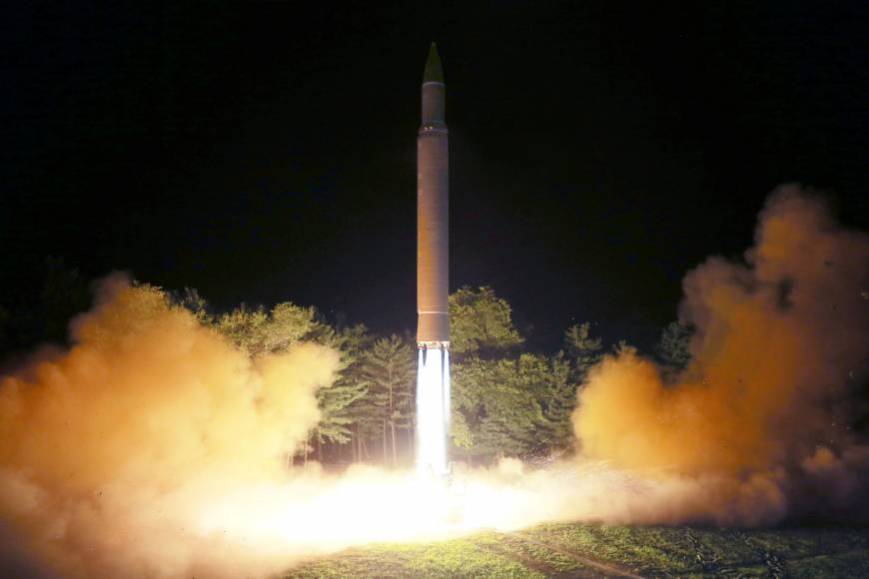
NHK video casts doubt on North Korean
ICBM re-entry capabilities and effectiveness

Video captured Friday of North Korea’s latest test of a powerful long-range missile appears to show the weapon’s re-entry vehicle “breaking up” over waters just off Hokkaido — a possible sign that the nuclear-armed country has yet to master technology critical to the warhead’s survival when returning to Earth, a report has found.
The report, released Tuesday by the North Korean-watching website 38 North, run by the U.S.-Korea Institute at Johns Hopkins University, analyzed video taken by Japanese public broadcaster NHK’s Muroran, Hokkaido, affiliate after Pyongyang conducted the second test-firing of its Hwasong-14 ICBM in less than a month late Friday.
Experts have said Friday’s test flew higher and longer than the first, and now puts a large chunk of the United States — including Chicago and Los Angeles — within range of Pyongyang’s ever-improving weapons systems.
In the NHK recording, the camera looks across a bay toward where the missile’s re-entry vehicle (RV) — which shields a nuclear warhead from the rigors of returning to Earth at ICBM velocities — crashed into the sea about 150 km off the coast of Hokkaido.
Seconds into the video, the apparent re-entry vehicle slows and becomes so hot due to the dense air that it begins to glow as its descent is recorded by the camera.
Then, at an altitude of about 6 to 8 kilometers, the re-entry vehicle hits what the report calls “peak radiance — when the clouds reflect the RVs radiance resulting in a bright flash.”
“Soon after the flash, the RV descends to roughly 4 or 5 km altitude, where the frictional forces that slow and heat the RV reach a maximum,” missile expert Michael Elleman wrote in the report.
Elleman, of the International Institute for Strategic Studies, said in an interview with reporters that as it then descends further, “you see, kind of, an incandescent cloud trailing the re-entry vehicle and you see small bright objects, radiant objects, that are shedding off the RV. And then it suddenly begins to turn very dim. That should not occur.”
If the re-entry vehicle had remained intact, he said, it would have continued to glow until it impacted the ocean.
Elleman said it “probably broke into small pieces,” disintegrating “about the time it experienced maximum stressing loads.”
Asked what would happen to any warhead being carried by a missile if its re-entry vehicle was destroyed in flight, Elleman said “the bomb itself … would be torn apart.”
“The fusing mechanism would be gone,” he said. “The battery or power source that provides the impulse to initiate the conventional explosive, which then initiates the nuclear bomb — I just don’t see how it would work.”
Friday’s ball of light was also spotted by several other cameras in western Hokkaido as it descended from the sky at 12:28 a.m., around the time when the missile was believed to be splashing down into the Sea of Japan.
Experts, including Elleman, said that given the timing and location, it was highly unlikely that the object could be anything other than the re-entry vehicle.
“In short, a reasonable conclusion based on the video evidence is that the Hwasong-14’s re-entry vehicle did not survive during its second test,” Elleman wrote in his report. “If this assessment accurately reflects reality, North Korea’s engineers have yet to master re-entry technologies and more work remains before Kim Jong Un has an ICBM capable of striking the American mainland.”
Kim was quoted last month by state-run media to have boasted that “the structural stability” of the warhead “showed normal operation even at the thousands of degrees of centigrade.”
But Elleman said that building a reliable re-entry vehicle appeared to be an ongoing process for the North, and that “a lot will depend on how much they actually learn from this test,” adding that two to three more tests of varying re-entry vehicle masses would likely be necessary.
“This might take them another six months, maybe a little bit longer, but the key is they’ll have to do some additional flight tests,” he said.
Kim, who has conducted more missile tests than both his father and grandfather combined, has shown no signs of slowing the breakneck speed at which he has ordered his teams to work in their quest for a credible nuclear weapon delivery system.
The North Korean dictator has even urged his nuclear scientists to “frequently send big and small ‘gift packages’ to the Yankees” in the form of yet more missile and nuclear tests.
South Korea’s Defense Ministry said Monday that the rival North was likely to continue its missile tests, as well as a sixth nuclear test “with more explosive power” than previous blasts.
